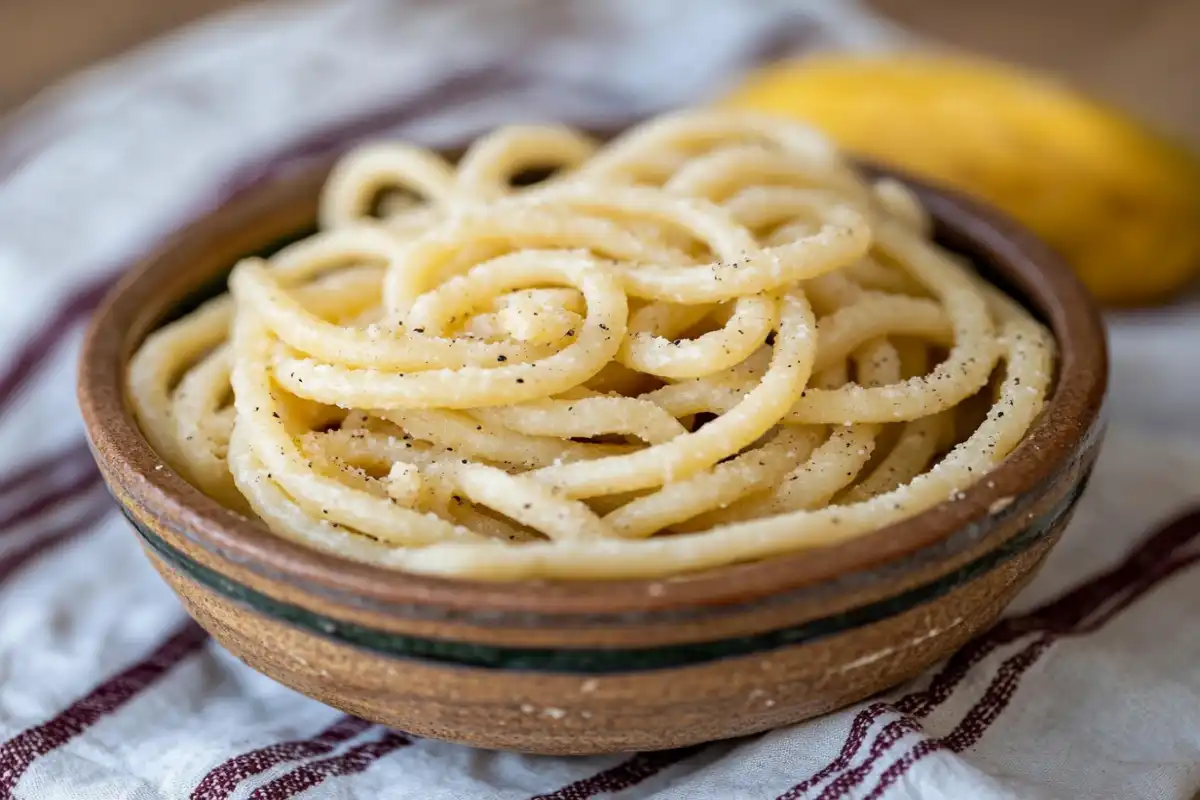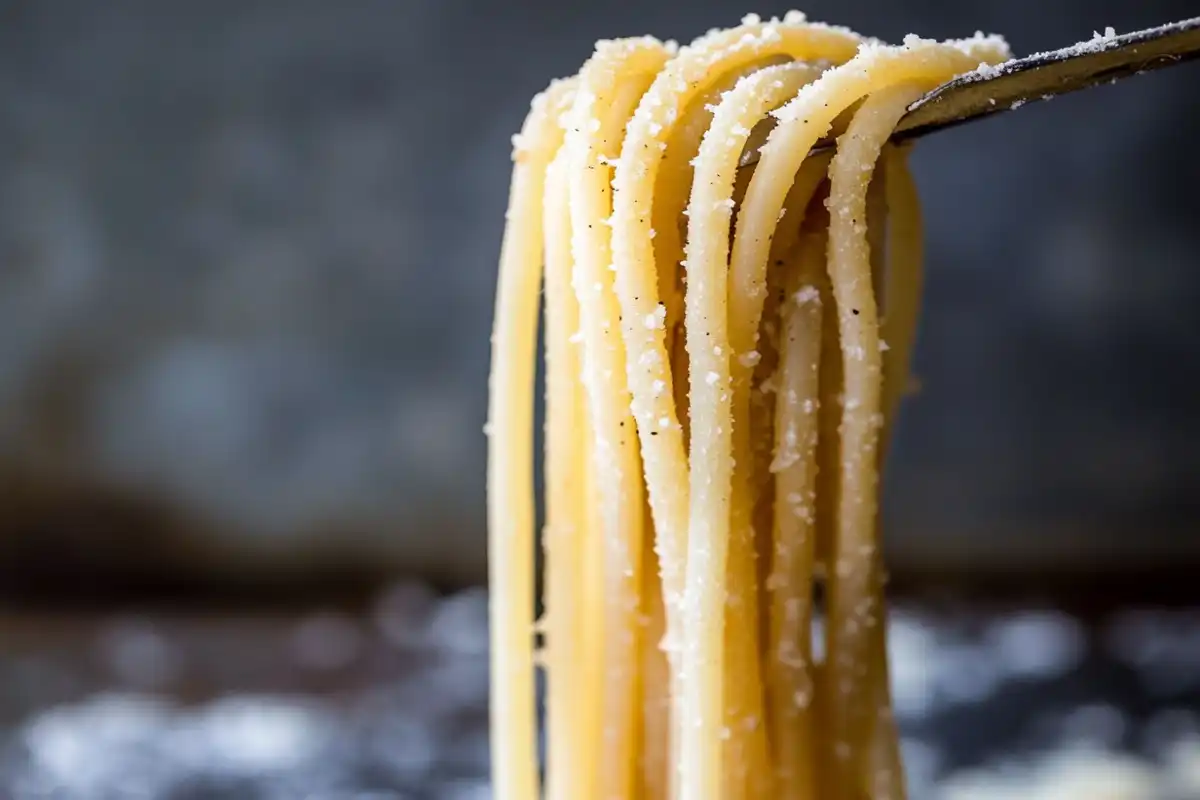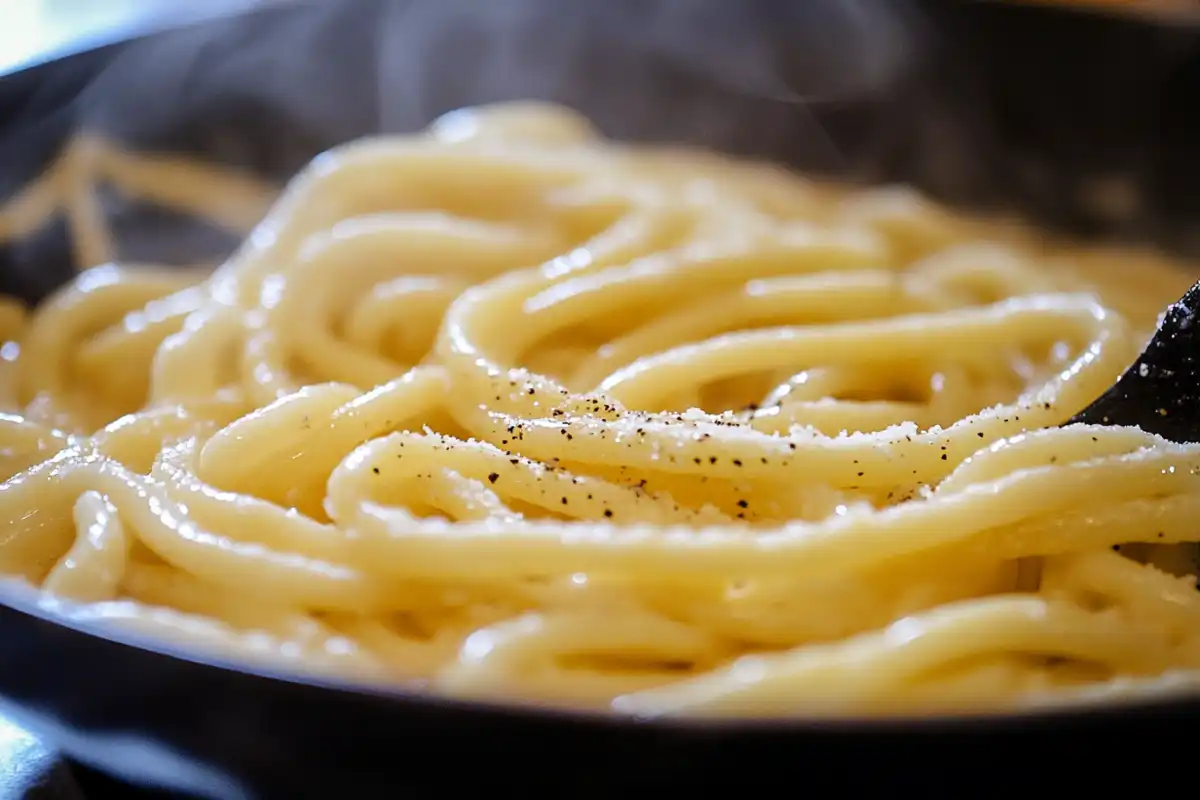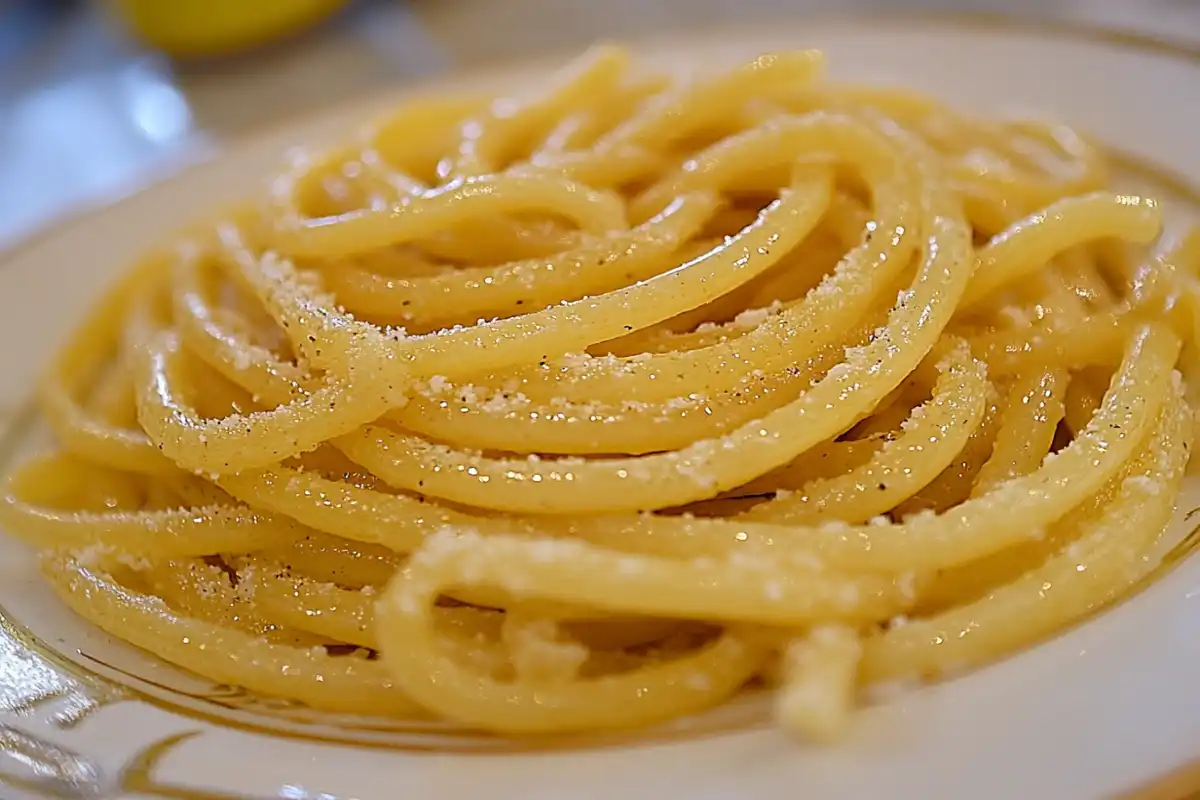Introduction to Bucatini Cacio e Pepe

Bucatini Cacio e Pepe is a classic Roman pasta dish that translates to “Sheep Herder’s Pasta.” This recipe is known for its simplicity and bold flavors. It uses just a few ingredients: bucatini pasta, Pecorino Romano cheese, and freshly cracked black pepper. These basic yet high-quality ingredients create a comforting and satisfying dish that showcases the heart of Italian cuisine. The rich, creamy texture comes from the combination of Pecorino Romano and starchy pasta water. Together, they form a velvety sauce that clings to each piece of pasta. The balance of flavors makes Bucatini Cacio e Pepe a favorite for those who love simple yet elegant Italian dishes.
For a deeper dive into the history of Cacio e Pepe, check out this History of Cacio e Pepe. Understanding the origins adds extra appreciation for this dish, as you learn about the cultural context that has kept it a beloved staple for centuries. This dish’s origins are about food, survival, resourcefulness, and transforming simple ingredients into a timeless experience.
History of Cacio e Pepe
Cacio e Pepe has roots in Roman cuisine, originating from the pastoral lifestyle of shepherds in the Lazio region. Shepherds chose its ingredients for their ability to be carried and stored easily during long journeys. This made it a reliable and nutritious meal. The simplicity of Pecorino Romano cheese, black pepper, and pasta created a hearty dish that could be made anywhere, even in rugged environments. This rustic dish embodies the resourcefulness of shepherds, turning a few humble ingredients into something extraordinary. The hearty nature of this dish provided energy and comfort, making it a staple for those who spent their days outdoors tending livestock.
If you need advice on cooking pasta perfectly for this recipe, check out this guide on Cooking Pasta Perfectly. Perfect pasta cooking is crucial to getting the right texture for Cacio e Pepe. Each bite should be al dente and absorb the rich, creamy sauce. Achieving the perfect consistency in the sauce also requires practice. Carefully combining pasta water and cheese avoids clumping and creates the silky texture that defines an excellent Cacio e Pepe.
What is Bucatini?
Bucatini is a thick pasta with a hole running through its center, similar to spaghetti but with added texture. This hollow feature allows it to hold more of the creamy Cacio e Pepe sauce, giving it a unique and delightful mouthfeel. The name “bucatini” comes from the Italian word “buco,” meaning hole. This characteristic sets it apart from other types of pasta. The hollow center captures the creamy sauce, making each bite even more flavorful. The thicker texture of bucatini provides a satisfying bite, and the hole helps distribute the sauce throughout the pasta. This ensures every mouthful is packed with the tangy, peppery goodness that defines Cacio e Pepe.
The versatility of bucatini makes it a favorite among pasta lovers who enjoy sauces that cling well to the pasta. Its unique texture works beautifully with creamy, rich sauces like the one used in Cacio e Pepe. Whether used in traditional Italian dishes or modern adaptations, bucatini adds a new dimension to any pasta dish, thanks to its ability to hold onto sauces and provide a delightful chewiness.
Key Ingredients for Bucatini Cacio e Pepe
- Pecorino Romano cheese: This sharp and salty cheese gives the dish its signature flavor. Made from sheep’s milk, it has a distinctive tang that perfectly complements the peppery notes. The quality of Pecorino Romano is essential, as it forms the base of the sauce. Using a well-aged cheese with a rich, complex flavor makes a noticeable difference.
- Black pepper: Toasted to bring out its full flavor, it adds depth and heat to the dish. Freshly cracked black pepper is essential for Cacio e Pepe. Toasting the pepper releases its essential oils, enhancing its complexity and giving the dish a more nuanced heat. The combination of Pecorino Romano and black pepper creates a perfect balance of salty and spicy that is central to the flavor.
- Bucatini pasta: The hollow center captures the sauce for a perfect bite every time. The thickness of bucatini ensures the pasta remains firm, even when coated in the creamy cheese sauce. The texture of bucatini makes it ideal for Cacio e Pepe. It provides the perfect base for the rich, peppery sauce, creating a harmony of flavors and textures in every bite.
How to Make Bucatini Cacio e Pepe
- Cook the bucatini: Boil in salted water until al dente, then reserve some pasta water. The starchy pasta water will be key in creating a smooth, creamy sauce that clings to every strand of pasta. Cooking the pasta until al dente ensures it retains a firm texture that stands up to the rich sauce.
- Toast the black pepper: In a large skillet, toast freshly cracked black pepper until fragrant. Toasting the pepper releases its essential oils, enhancing its flavor and giving the dish a more complex and aromatic quality. The toasted pepper should fill your kitchen with its spicy aroma, indicating it’s ready to be combined with the other ingredients.
- Create the sauce: Add reserved pasta water to the skillet, then stir in Pecorino Romano cheese until a creamy consistency forms. The heat and starch from the pasta water help emulsify the cheese, creating a velvety sauce that evenly coats the pasta. To achieve a smooth sauce, add the cheese gradually while stirring constantly. This ensures it melts evenly without clumping.
- Combine: Add the cooked bucatini and toss to coat evenly, ensuring the pasta is fully covered in the creamy sauce. Stir vigorously to help the sauce cling to the pasta. This step is crucial for maximum flavor.
Tips for Perfecting Bucatini Cacio e Pepe
- Pasta water: The starchy pasta water is essential for emulsifying the sauce and creating a creamy texture. Without it, the cheese can become clumpy rather than smooth, so reserve enough water before draining the pasta. The starch in the pasta water acts as a binding agent, allowing the cheese to melt smoothly and create a cohesive sauce.
- Toasting black pepper: Toasting enhances its flavor, bringing out the best in the dish. Use freshly cracked pepper for maximum flavor, as pre-ground pepper lacks the same aromatic intensity. The fresher the pepper, the more vibrant the dish will be, so it’s worth taking the time to crack the peppercorns yourself.
Why Bucatini Cacio e Pepe is Popular

Bucatini Cacio e Pepe is celebrated for its rich flavor and simplicity. The combination of Pecorino Romano cheese and black pepper makes it a comforting dish that’s perfect for any occasion. It has become a staple in Italian households and is beloved worldwide for turning humble ingredients into a gourmet experience. The dish’s minimalist approach resonates with those who appreciate straightforward yet deeply satisfying food. Its popularity has grown as people seek out comforting, homemade meals. The satisfaction of creating something delicious with just a handful of ingredients is a major part of its appeal.
The simplicity of Bucatini Cacio e Pepe means you can make it quickly, making it an ideal choice for a weeknight meal or a last-minute dinner party. It relies on pantry staples, so you can make it without a trip to the grocery store, adding to its convenience. Despite its simplicity, the dish delivers complex flavors that make it feel special. Its rich, creamy texture is pure comfort food at its finest.
Cultural Significance
This dish holds a special place in both Italian and Roman cuisine. It showcases the minimalist yet rich approach to cooking that characterizes Italian food culture. In Rome, Cacio e Pepe is often served in traditional trattorias, where its simplicity is celebrated as a testament to the culinary heritage of the region. The dish exemplifies the Italian philosophy that great food does not need to be complicated. It only needs quality ingredients and careful preparation. The emphasis on simplicity and quality ingredients reflects broader cultural values of Italian cuisine, where the focus is always on bringing out the natural flavors.
In Rome, enjoying a plate of Cacio e Pepe is more than just a meal—it is a cultural experience that connects diners to the history and traditions of the region. Generations have passed down this dish, and its enduring popularity is a testament to its timeless appeal. Whether enjoyed at a bustling trattoria or prepared at home, Cacio e Pepe brings people together. It celebrates the joy of good food and good company.
Variations of Cacio e Pepe

- Different cheeses: Some versions use Parmesan in addition to or instead of Pecorino Romano. This variation can create a milder flavor profile, but purists often stick to Pecorino Romano for its sharp, distinctive taste. Combining different cheeses can add layers of flavor, but it’s important to balance the saltiness and texture to maintain the dish’s character.
- Additional spices: A few recipes add a hint of red chili flakes for extra heat. While not traditional, this can add a new dimension to the dish, balancing the creaminess of the cheese with a touch of spice. Adding chili flakes can provide a pleasant contrast to the richness of the sauce, creating a more dynamic flavor profile that appeals to those who enjoy a bit of heat.
Conclusion
Bucatini Cacio e Pepe remains a timeless classic, combining simple ingredients into an unforgettable dish. Its creamy sauce, toasted black pepper, and chewy bucatini make it a must-try for any pasta lover. The appeal of this dish lies in its balance of flavors and textures, showing how even the most basic ingredients can come together to create something extraordinary. Whether enjoyed at a cozy Italian trattoria or made at home, Bucatini Cacio e Pepe brings people together around the table to share in its comforting, rich flavors. The simplicity of the dish makes it approachable for cooks of all skill levels, while its depth of flavor keeps people coming back for more. It is a true celebration of Italian culinary tradition—unpretentious, full of flavor, and always satisfying.
FAQs
- What does “Cacio e Pepe” mean?
- It translates to “cheese and pepper,” highlighting the two key ingredients of the dish.
- What is the difference between Bucatini and Spaghetti?
- Bucatini is thicker and has a hollow center, which allows it to hold more sauce compared to spaghetti. The hollow center of bucatini gives it a unique ability to soak up and hold onto the sauce, enhancing the overall flavor.
- How do you prevent the cheese from clumping?
- Use hot pasta water to emulsify the cheese and stir continuously. The heat and starch from the pasta water help create a smooth, cohesive sauce. Gradually adding the cheese and stirring constantly also prevents clumps and achieves a silky texture.
- What type of cheese is traditionally used in Cacio e Pepe?
- Pecorino Romano is traditionally used for its sharp flavor, which contrasts beautifully with the black pepper and adds depth to the dish. The sharpness of Pecorino Romano is essential to balancing the peppery heat, making it the ideal choice for this classic dish.
- Can I use a different type of pasta for Cacio e Pepe?
- While bucatini is a popular choice, other types of pasta like spaghetti or tonnarelli also work well. The key is to use a pasta shape that can hold the sauce and provide a satisfying texture. Tonnarelli, in particular, is a traditional choice that works well due to its thick, square shape, which provides a similar texture to bucatini.
For more information
